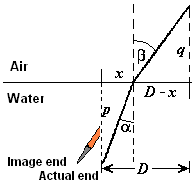Chapter 4
Differential Calculus and Its Uses
Project 2: Refraction
In this project we analyze the refraction of light using
| Fermat's Principle Light follows a path that minimizes total travel time. |
 An experiment: Fill a glass with water, and place a pencil in the water at an angle (not vertical). Notice the apparent bend in the pencil at the surface of the water? You know the water is not actually bending the pencil, so it must be bending the light rays from the pencil to your eye. More precisely, a light ray from a point on the pencil (say, the bottom end) travels through the water along a straight line to the surface, and then it changes direction to travel along another straight line to your eye.
An experiment: Fill a glass with water, and place a pencil in the water at an angle (not vertical). Notice the apparent bend in the pencil at the surface of the water? You know the water is not actually bending the pencil, so it must be bending the light rays from the pencil to your eye. More precisely, a light ray from a point on the pencil (say, the bottom end) travels through the water along a straight line to the surface, and then it changes direction to travel along another straight line to your eye.
 |
In contrast to reflection, with refraction there isn’t just one speed of light, but two — one speed in air and one in water. In general, light has a different speed for each medium through which it travels.
The symbol `c` is commonly used for the speed of light. Suppose we write `c_a` for the speed of light in air and `c_w` for the speed of light in water. Similarly, we can write `T_a=T_atext[(]x text[)]` for the travel time of the light ray through the air and `T_w=T_wtext[(]x text[)]` for the travel time through water. The travel times are functions of `x` because they depend on where the ray passes from water to air on its way from the pencil tip to the eye. Then, because the speed is constant in each medium, `c_w T_w` is the distance traveled through water, and `c_a T_a` is the distance traveled through air.
- Show that the total travel time `Ttext[(]x text[)]` is given by
`Ttext[(]x text[)]=sqrt(p^2+x^2)/c_w+sqrt(q^2+text[(]D-xtext[)]^2)/c_a`
for any `x` between `0` and `D`. - Calculate `T'text[(]x text[)]`.
-
Show that `Ttext[(]x text[)]` is minimized when
`(sin alpha)/c_w=(sin beta)/c_a`.
- Use (c) to justify the classic description of the angle of refraction:
Snell's Law The ratio of the sine of the angle of incidence to the sine of the angle of refraction is a constant. - Show that the second derivative of `T` is always positive, and therefore that any solution of `T'text[(]x text[)]=0` is the `x`-coordinate of a minimum point.